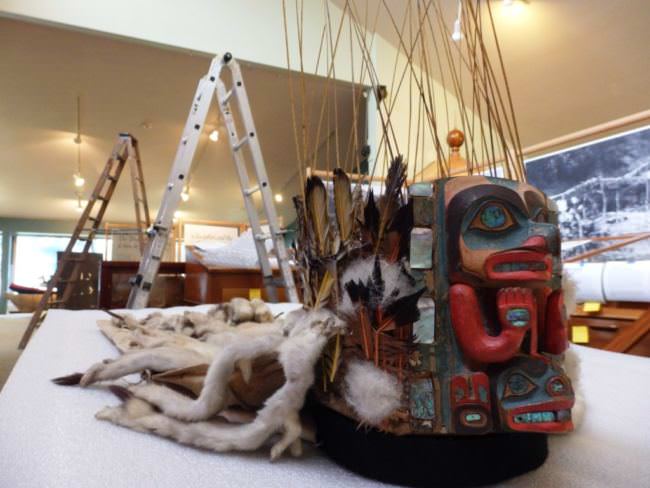
The Haines area used to be a Tlingit stronghold, ruled by an alliance between the prosperous Chilkat and Chilkoot people. A new Haines Sheldon Museum exhibit explores how the Native territory gradually gave way to white settlement in the late 1800s. The exhibit will anchor the museum’s upstairs space for at least two years.
The exhibit is called “Everything From Afar Drifts Ashore.” It is the meaning for the Tlingit name “Yandeistakye.”
Yandeistakye was a Tlingit village located near the current Haines airport. It was the site of some of the 19th century’s most influential contact between Natives and white visitors in this area.
Haines author Dan Henry recounts this time in his recently-published book “Across the Shaman’s River.” The museum exhibit is partially based on the book.
Henry says, for much of the 1800s, the Chilkat and Chilkoot Tlingits staved off white settlement.
“The Northern Tlingits were very effective at defending the area,” Henry said. “They pretty much would escort people out. So there was never a military attack or opportunity to gain a foothold.”
That’s where the museum exhibit begins. It starts with a map of the Jilkaat Aani – the territory of the Chilkat and Chilkoot people.
“We start in 1850,” said museum director Helen Alten. “When the Russians and Europeans and Americans have all been trading in this area, but none of them have been in Jilkaat Aani to stay.”
But Henry says that changed after the arrival of naturalist John Muir.
Russia sold it Alaska territory to the U.S. in 1867. Twelve years later, Muir travelled to the Chilkat Valley to study glaciers. He accompanied a Christian missionary named S. Hall Young.
When they arrived, they met with Tlingits in Yandeistakye.
“[Muir] gave a short speech that was essentially a Unitarian speech, all he talked about was brotherhood,” Henry said. “He said ‘we’re brothers.’ So he talked about it from a horizontal status rather than vertical, top-down. Muir said, ‘you and I are the same.’ And that’s exactly what the Tlingits wanted to hear and they said ‘OK, we’re with you.’”
Zack James is Tlingit and grew up in the Chilkat Valley. His great-grandmother lived in Yandeistakye.
“There are very few writings in that time period about what the Tlingit people actually thought,” James said. “Everything is second-hand.”
James is a student at the Institute of American Indian Arts in Santa Fe. He helped with research for this exhibit. He says the Tlingits were feeling pressure to make a compromise with the Americans.
“Some of the leaders in the Tlingit community noted just how many American ships were coming up to Alaska,” James said. “And I think they got the impression that Americans were a hugely powerful force and that hostility wasn’t going to benefit them in the long-run.”
Tlingit leaders selected land known as Deishu for a Christian mission and school. Deishu later became Haines.
“[In] 1879, they sealed the deal on Deishu,” Alten said. “Then, because of that, the word went out that it was opened up.”
Entrepreneurs, missionaries, teachers, miners and the military started to arrive. The exhibit tells the stories of some of the first non-Natives to make a home in Haines.
James says Tlingits valued education and knowledge. But many of the schools during this time period repressed the Native culture. His grandparents went to boarding schools where they weren’t allowed to speak their language.
“The goal, I suppose, was to try to sever that cycle of knowledge from being passed down from grandparent to grandchild and parent to child,” James said.
The last section of the exhibit asks who Haines is now. It displays modern Tlingit artwork from Wayne Price and Lani Hotch. But it also points out that in this former Tlingit stronghold, Haines’ population is now just 11 percent Alaska Native. The village of Klukwan, which used to be home to 2,000 people, now has a population of about 100.
Alten says the loss of land came up during meetings with Native elders leading up to this exhibit.
“It’s something that we want people to figure out on their own,” Alten said. “We’re not going to interpret it for people, we’re just trying to give them what it is.”
As for John Muir, the white naturalist who connected with Tlingit leaders…
“He left and never came back,” Henry said.
The author says this chapter in Haines history is full of irony.
“Muir went on a speaking tour down south and said, ‘The last hostile heathens are now mollified, the hills are now open for gold prospectors,’” Henry said. “So this book ends by saying John Muir, the founder of American environmentalism, started the Klondike Gold Rush. Which some in Yukon have called the largest environmental disaster in the Yukon.”
The checkered history of the non-Native impact on Jilkaat Aani and surrounding lands will be on display at the Haines Sheldon Museum for at least two years.
The opening Friday included a 7 p.m. talk from Henry. He will also be in Skagway to talk about “Across the Shaman’s River” Sunday at 2 p.m.